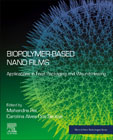
Biopolymer-Based Nano Films: Applications in Food Packaging and Wound Healing
Rai, Mahendra
Dos Santos, Carolina Alves
The possibility of associating nanotechnology with biotechnology helps with the creation of innovative new products and the development of processes at the molecular level, this being promising for the development of clean processes with less toxic waste, high selectivity, high value, and having great market interest. Within this context, nanobiotechnology advances and revolutionizes several scientific fields having an interdisciplinary character. In the development of new technologies and products it is also necessary to develop platforms that allow the specific application and delivery of compounds/actives in a controlled, specific, and non-toxic way, being therefore, both a challenge and a scientific possibility. This book covers a variety of biofilms, including active biofilm, nisin-silver nano-film, silk fibroin-based composite film, lignocellulose/cellulose-based biofilm, carboxymethyl cellulose-coated polypropylene, hybrid film-loaded antimicrobials, chitosan hybrid systems, pullulan, and biopolymers films. The applications of these nano-biofilms in different fields, particularly in food packaging, wound healing, and as potential antimicrobials against new, emerging, and multidrug resistant microbes, are also discussed. This is an important resource for researchers in the fields of pharmacology, nanotechnology, microbiology, biotechnology, and clinicians. Covers a variety of biofilmsOutlines the fundamental properties and major applications of nanostructured biofilmsAssociates nanotechnology with biotechnology helping with the creation of innovative new products and the development of processes at the molecular level INDICE: Section I: General 1. Biopolymer-based Nano-Films: What are they? And how they are useful in food packaging and wound healing 2. Pullulan films and natural compounds: Applications and perspectives 3.Production and Applications of Nanobiocellulose films Section II: Application of Biopolymer-based Nano-Films in Food packaging 4. Active biofilm for Food-packaging 5. Nisin loaded Nanoparticles in Food Preservation 6. Nanoparticles embedded Silk fibroin based composite films for wound dressings 7. Carboxymethyl cellulose-coated polypropylene films containing essential oil for Food preservation Section III: Application of Biopolymer-based Nano-Films in wound healing 8. Ligno-cellulose based nano-biofilm using plant biomass and their role in wound healing 9. Cellulose nanofibrils in bio-nano composite films and their applications in drug delivery 10. Antibacterial and wound healing activities of micro/nanocarriers based on carboxymethyl and quaternized chitosan derivatives 11. Nano-biofilm-natural components as future drugs for the treatment of burn wounds 12. Hybrid films-loaded nano antimicrobials 13. Nanocomposite antimicrobial films based on biopolymers 14. Application of nanoparticles impregnated chemical polymer films against microbial biofilms 15. Nanocoating biopolymer using leaf biomass derived nanocellulose for wounds 16. Nano-biofilm-natural components as future drugs for the treatment of burn wounds 17. EO-based films and their role as antimicrobials 18. Nanoencapsulation of natural compounds for the treatment of vulvovaginal candidiasis and paracoccidioidomycosis 19. Biopolymer-based nano- films in Dermatology 20. Biopolymer based nano films: Utility and Toxicity 21. Regulations for using Nanotechnology in Food and medical products
- ISBN: 978-0-12-823381-8
- Editorial: Elsevier
- Encuadernacion: Rústica
- Páginas: 400
- Fecha Publicación: 01/02/2021
- Nº Volúmenes: 1
- Idioma: Inglés
